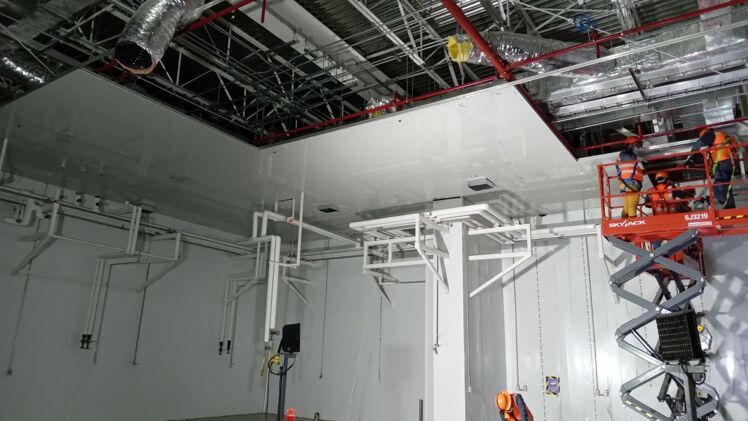Clean Room Installation: Ensuring Precision and Quality in Critical Environments
- 2024-01-13
- View 10
Clean rooms play a critical role in various industries, including pharmaceuticals, biotechnology, electronics, aerospace, and research. These controlled environments are designed to minimize contamination, ensuring the production of high-quality products and reliable research outcomes. In this article, we will explore the intricacies of clean room installation and the essential steps involved in creating a functional and compliant clean room facility.

1. What is a Clean Room?
A clean room is a controlled environment with a low level of pollutants, such as dust, airborne microbes, aerosol particles, and chemical vapors. Maintaining precise control over environmental factors, such as temperature, humidity, and air cleanliness, is crucial in clean room design and installation.
2. The Importance of Clean Room Installation
Clean room installation is a critical process that significantly impacts the overall performance of the facility. A well-designed and properly installed clean room ensures product integrity, employee safety, and compliance with industry regulations. It provides a controlled environment where sensitive processes can take place without the risk of contamination, ultimately leading to consistent and reliable results.
3. Planning for Clean Room Installation
Before embarking on a clean room installation project, meticulous planning is essential. This phase involves understanding the specific requirements of the clean room, identifying the processes that will occur inside it, and establishing the necessary cleanliness level based on industry standards and product needs.
4. Choosing the Right Location
Selecting the optimal location for the clean room is crucial for its efficiency and functionality. Factors such as proximity to existing production areas, ease of access for personnel, and availability of utility connections must be considered during site selection.
5. Designing the Clean Room Layout
An efficient clean room layout should be designed to ensure smooth operations and minimal contamination risk. The layout should accommodate the flow of materials, personnel, and equipment while maintaining strict segregation between different clean room zones.
6. HVAC System and Airflow Considerations
The HVAC (Heating, Ventilation, and Air Conditioning) system plays a vital role in maintaining air cleanliness and temperature control. Proper airflow patterns should be designed to ensure uniform distribution of clean air throughout the clean room.
7. Selecting Proper Clean Room Materials
The selection of suitable materials for clean room construction is essential to prevent particle generation and facilitate easy cleaning and sterilization. From walls and ceilings to flooring and furniture, every component must meet the required standards.
8. Installation of Clean Room Components
The clean room installation process involves assembling and setting up various components, such as wall panels, ceiling grids, flooring, lighting, and clean benches. Each step must be executed with precision to maintain the integrity of the controlled environment.
9. Ensuring Compliance with Regulations
Compliance with industry standards and regulations is crucial for the successful operation of a clean room facility. Clean room installers must ensure that the design and construction adhere to guidelines set forth by organizations such as ISO, FDA, and GMP.
10. Testing and Validation
Thorough testing and validation are conducted to ensure that the clean room meets the specified cleanliness levels and operational requirements. These tests include particle counts, airflow velocity measurements, and leak tests to verify the effectiveness of the clean room system.
11. Training and Maintenance
Proper training of personnel working in the clean room is essential to maintain cleanliness and prevent contamination. Additionally, regular maintenance and cleaning protocols should be established to prolong the life of the clean room and sustain its optimal performance.
12. Clean Room Upgrades and Modifications
As technology and processes evolve clean rooms may require upgrades or modifications. Whether it's the installation of advanced filtration systems or expansion to accommodate increased production, careful planning and execution are necessary to maintain a controlled environment.
13. Common Challenges during Clean Room Installation
Clean room installation can present various challenges, such as budget constraints, tight schedules, and unforeseen technical issues. Overcoming these challenges requires effective communication, adaptability, and a proactive approach to problem-solving.
14. Conclusion
In conclusion, clean room installation is a meticulous and crucial process that demands attention to detail and adherence to industry best practices. A well-designed and properly installed clean room ensures precision, quality, and reliability in critical environments, supporting industries that rely on contamination-free processes. By following the outlined steps and guidelines, companies can create clean room facilities that meet regulatory standards and provide a controlled environment for vital operations.
FAQs
1. How often should a clean room be validated?
Clean rooms should be validated initially after installation and then regularly, typically every six months, to ensure ongoing compliance with cleanliness standards.
2. Can a clean room be modified to accommodate new processes?
Yes, clean rooms can be modified and upgraded to accommodate new processes or technologies. However, it should be done with careful planning and consideration of potential impacts on cleanliness and performance.
3. What ISO class is suitable for pharmaceutical clean rooms?
Pharmaceutical clean rooms often aim for an ISO 5 (Class 100) or better classification, depending on the specific requirements of the manufacturing processes.
4. Are clean room garments essential for personnel?
Yes, clean room garments, including gowns, gloves, and masks, are essential for personnel working inside the clean room to minimize the introduction of particles and contaminants.
5. Can clean room installation be outsourced to specialized companies?
Yes, many companies specialize in clean room installation and can provide expertise and resources to ensure a successful and compliant installation process.
Kwang Cleanroom is proud to offer examples of a variety of our cleanroom projects below. Laminar Flow Clean Room, Clean Room Production, ISO Room, 100000 Level Purification Workshop, ISO 4 Cleanroom, Clean Room Level, Cleanroom ISO 6.
